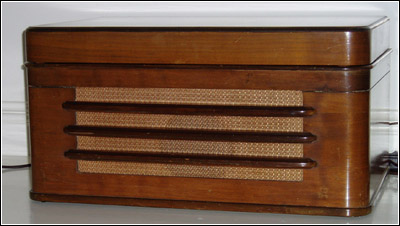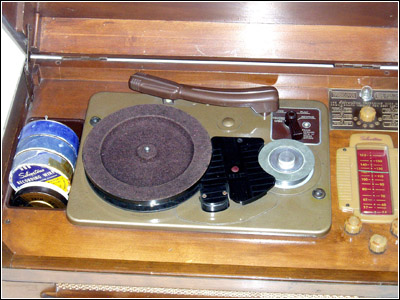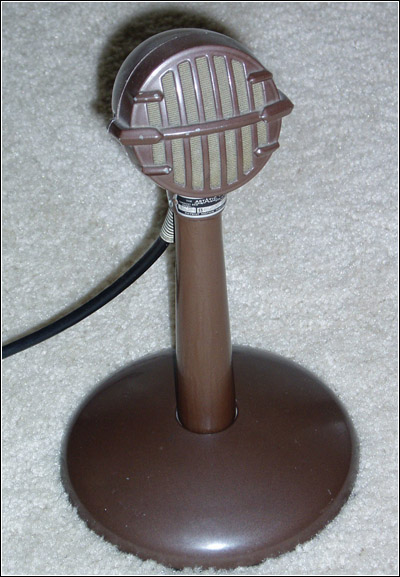Of Old Radios And Related Items--Published Monthly
The Beginning -- A Silvertone Wire Recorder
A Journey to Becoming a Collector
BY JOE CURIALE
WEB EDITION
Joe Curiale's long journey with a family wire recorder over several decades resulted in his becoming an avid collector. It's never too late to begin could be the moral of his story. (Editor)
My earliest memory of the Silvertone 7086 wire recorder, shown in Figure 1, was at my grandmother's kitchen table with all of us gathered around listening and talking. The big, black iron fan whirred away on the counter, taking the edge off those hot, humid summer days in Chicago. It was a time when aunts and uncles, cousins, brothers and sisters still gathered together for a Sunday meal -- pasta and meatballs, of course. And while the cooking was underway, it was time to fire up the old wire recorder.
In fact, the set wasn't too old in those days -- maybe only ten or fifteen years. Just a few years earlier, not long before the United States entered World War II, the Armour Research Foundation had developed the wire recorder as we know it today. During the war, the U.S. military used them to record the audio of battle events and, some say, to record and play back messages of the Navajo code-talkers working with the Marines during the Pacific war. (This information on wire recorders, and much more, can be found on web sites, such as www.videointerchange.com/wire_recorder1.htm.)
Figure 1. The Sears Silvertone 7086, manufactured in 1947 and originally purchased in 1948.The set in grandma's kitchen was built in 1947 under a license granted to Sears, and sold as a Silvertone. It is a large wood-cabinet tabletop, and in 1948, my father and his brother Bennie each bought one. The exterior cabinet dimensions are 22" wide x 111/4" high x 14" deep. The outline of the circular speaker cone can be seen through the grille cloth in the front, behind the three horizontal bars. The finish is original. The Model 7086 has seven tubes and five electrolytics, but back then I didn't know anything about that. What caught my eye was a turntable that played 78 records and a radio that played a single band (AM).
Strangest of all was a vertically reciprocating recording head positioned between a large take-up reel (which doubled as the turntable) and a small spool of stainless steel wire. The wire, when playing, flew past the head at more than 20 inches per second, or so Uncle Bennie claimed. Figure 2 shows the layout of the interior. (For a color photo of a similar model, take a look at www.west-techservices.com/images/silv7103a.jpg.)
At that time I didn't know how it could record sound on a steel wire and play it back, and I didn't care. What I did know was that it had a very cool, old-style microphone, as shown in Figure 3, connected by a long wire to the back of the set, and we could talk and sing into that mike and hear our voices played back immediately. For a 5-year old kid, it didn't get any better than that.
The Model 7086 in the 1960s-1970s
My father's Silvertone stopped working sometime around the mid-'60s. When my uncle's set starting faltering a few years later, both were retired. They ended up sitting on Uncle Bennie's basement workbench for years, along with assorted other radios and TVs and some impressive-looking test equipment. He had a knack for fixing anything, but he never quite got around to those Silvertones.
Figure 2. Silvertone 7086 interior. The sliderule tuning dial shown at the far right has knobs below it which are volume, tuning, on-off/tone. The 6-position selector above the tuning dial activates radio, phonograph, wire play, wire record, etc. The indicator just above the selector knob is used to set recording level. The stainless steel wire spool (23/4" dia.) is mounted on the right side of the "floating" playing deck, and the switch controlling the turntable and wire reel is immediately above the spool. The turntable (61/2" dia.) doubles as the wire take-up reel. The recording/playback head at the bottom center reciprocates vertically to force the wire to distribute evenly on the take-up reel during playback and on the wire spool during rewind. The tray to the left of the playing deck holds up to five wire spools.In 1969, my parents finally got fed up with the cold winters and hot summers of Chicago, and we made tracks west for the one-season climate of southern California. The wire recorder sets were left behind, and life carried on. No more big family get-togethers and no more talking into that cool microphone on Sunday afternoons.
Then Uncle Bennie decided to make the same move west several years later -- I think it was around my mid-college years -- and got rid of a bunch of stuff, including that old wire recorder which, he said, probably didn't work. Why I agreed to take it, I don't know, but it ended up underneath a pile of stuff in a neglected closet of my apartment -- wire spools inside and microphone stuffed in the cavity at the back of the cabinet. As far as I knew, none of it worked, and I didn't care, at least not then.
Time melted away, and for reasons I still don't recall, I took the Silvertone out one day, blew away 15-plus years of accumulated dust, and took a good hard look. This was the late 1970s and Radio Shack still had tube testers in a few of their stores. I found one, checked all seven tubes in the 7086, replaced the bad ones, fired it up, and guess what? Sound came out! Not great sound. Not even good sound. But it was my first experience bringing an old radio back to life, and I never forgot it.
The Model 7086 in the 21st Century
But before long the Silvertone went back into the closet -- various closets, in fact, as I moved from place to place, and another 20-plus years went by. A new century was upon us, and once again I dusted off the old set, placed it in a conversation-piece location in our home, and fired it up. Sound came out, but nothing you'd recognize -- original family recordings from the '40s through the '60s. I thought about all those voices still on the wire spools, many no longer with us. No question about it: I had to get it working, and working well.
Out it went to my garage workbench, which isn't as classy or well-equipped as the one in Uncle Bennie's basement, but it'll do. Out came the chassis for a thorough cleaning. And then two things occurred to me. First, it was 2003, and Radio Shacks didn't have tube testers anymore. And second, I didn't really know what I was doing anyway, so why bother?
It took a while, but I found nearby one of those oldtime radio/TV places that time seems to have passed by, and it still had a tube-tester. Unfortunately, that's all it had -- no N.O.S. tubes were available, and worse yet, the folks there had never even heard of wire recorders!
Figure 3. The Astatic Model W80 microphone (original) shipped with the Silvertone 7086.A quick check indicated that the 50L6 power amp tube was bad. They found an old one that tested okay, I put it in, and it made no difference. And despite my best intentions, two more years went by.
That brings us to the year 2005 when I first developed and scratched the itch to collect and repair antique radios. It started with one-too-many house guests pointing to the wire recorder and asking, "Does that thing work?" So the old Silvertone finally got dusted off again, and I hit Google hard. I was lucky to find Fred Wuensche of Wireless Workshop (www.wireless-workshop.com) in nearby Houston. Fred recapped the set, including the five electrolytics, all of which were still in their original paper, and checked the tubes in detail. When it came back home, the set sounded great: Stations came in strong, 78s played their old music once again, and most importantly, that old stainless steel wire flew by the recording/playback head just as it used to, and out came voices from the '40s, '50s and '60s.
There were stories in Italian by grandparents, two of whom I never knew; songs by aunts and uncles, none of whom ever made it to Broadway (for good reason); and "interviews" by my father with brothers, sisters, and cousins, including me, almost 50 years ago. Fred had resurrected more than just a radio.
A Serious Collector Emerges
Hearing that dead wire recorder come back to life is what got me started. I found a wealth of information for radio collectors, including magazines like A.R.C., read everything I could, and started to keep an eye out for old radios in antique shops and garage sales. Collecting and repairing antique radios has taken up much of the past half-decade, and will certainly be a big part of the decades to come.
Our place in Texas is now sprinkled with radios ranging from the late 1920s to early 1950s, up to the limits of the house's space and my wife's patience. There are tabletops and chairsides. There are consoles, including a beautiful black-dial Zenith and a magnificent Splitdorf Lorenzo. The sets came from as far away as Mexico (including my father-in-law's treasured 1948 tabletop), Norway (a portable from our good friends in Stavanger), and what is now the Czech Republic (it was still Czechoslovakia when the radio was manufactured, just after the war).
They came from auctions, both the live kind and the eBay kind; from antique stores; from family, friends and strangers. One special small Silvertone tabletop AM/SW set belonged to my Uncle Pete, a former Ham radio enthusiast in Michigan. Brand names range from A (Andrea 3D5, 1937) to Z (Zenith 6-S-254, 1938), with much in between: David Anderson, Hallicrafters, Macys, Philco, Silvertone, Splitdorf, Stewart-Warner, Tesla. Some came in the door working just fine, but most didn't, and these were learning opportunities.
Tube testing (you can find some great and some not-so-great testers on eBay) and re-capping are now part of my routine these days, and I know there's still a huge amount to learn. There's that Philco 46-350 rolltop portable out on the bench right now -- the same model owned by Joe DiMaggio, which stubbornly wants to tune in static rather than stations. And the Zenith 4K2616 set that I couldn't figure out why I had won for such a low bid on eBay until it arrived, and I saw it was a battery-only set! So learning how to build a battery eliminator circuit is on my post-retirement list. And that list is getting longer all the time!
Through it all the Silvertone 7086 keeps on playing. We spin some old 78s now and then, and run the wire recorder when friends visit. It's amazing how many of our first-time visitors, even those a bit long in the tooth, have never heard of recording on wire.
That set has come a long way since 1948. It's now a family heirloom, with memories that stream from a wire at the flip of a switch. But its importance goes even further, because it opened a window to the magic of oldtime radio, and revealed the joy of a wonderful new hobby.
References:
www.videointerchange.com/wire_recorder1.htm.
www.wireless-workshop.com
www.west-techservices.com/images/silv7103a.jpg
Joe Curiale became a serious collector about five years ago with a particular interest in wooden tabletops and consoles from the 1920s through the 1940s. After starting collecting, he also tried his luck at repairing and found the former a lot easier than the latter. But, his batting average is good, having encountered only three radios so far that he hasn't been able to bring back to life. He looks forward to retirement when a paying job won't get in the way of his hobbies.
|
[Free Sample] [Books, etc., For Sale] [Subscribe to A.R.C./Renew] [Classified Ads] [Auction Prices] [Event Calendar] [Links] [Home] [Issue Archives] [Book Reviews] [Subscription Information] [A.R.C. FAQ]URL = http://www.antiqueradio.com/May10_Curiale_Silvertone.html Copyright © 1996-2010 by John V. Terrey - For personal use only. Last revised: April 25, 2010. For Customer Assistance please contact ARC@antiqueradio.com or call (866) 371-0512 toll free Antique Radio Classified |



